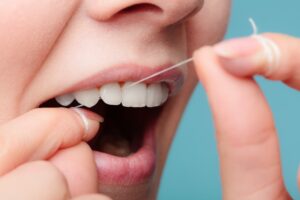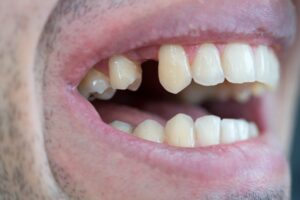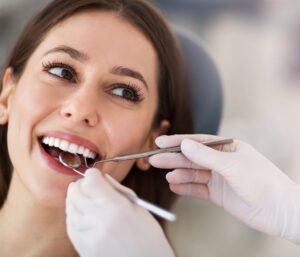Header logo
header top contact widget
Alzheimer’s Disease
Gift Ideas For “Priceless” Smiles!
Posted on Sep 25, 2024 by William J. Claiborne, DDS MS
 It’s not even October and already I’m seeing holiday sales ads and decor. This comes across as pretty confusing when Christmas items are mixed into Halloween candy and skeleton costumes.
It’s not even October and already I’m seeing holiday sales ads and decor. This comes across as pretty confusing when Christmas items are mixed into Halloween candy and skeleton costumes.
However, Americans are wise to get a jump on the holidays since the rush of the Christmas season can become overwhelming. A long holiday shopping list can often be more manageable by jumping on early sales, saving time and money. Like every list, though, there is always that hard-to-buy-for person. At Biltmore Periodontics in Asheville, we have a suggestion…
An electric toothbrush can do a lot more than help an individual enjoy fresh breath and a bright smile. Studies have shown that brushing teeth with an electric version promotes better gum health and slower progression of periodontal (gum) disease. Compared to manual toothbrushing, an electric toothbrush can help to reduce the risk of tooth loss.
As part of a thorough at-home oral hygiene regimen, the thoroughness of an electric toothbrush was monitored in one study (published by the Journal of Clinical Periodontology). In this, the oral health of over 2800 adults was tracked for over 11 years. The use of electric toothbrushes was monitored to watch for periodontal disease, cavities, and the number of natural teeth.
From 2002 – 2006, participants were examined with follow ups conducted after 6 and 11 years. Eighteen percent of the participants were electric tooth brush users. At the time of their 11 year follow up, 37% had switched to using electric toothbrushes.
The study showed electric brushing promoted better gum health and slower progression of gum disease. Electric tooth brushing is also related to a reduction in tooth loss by 20% (compared to those who brush with manual toothbrushes).
https://www.ncbi.nlm.nih.gov/pmc/articles/PMC6619286/
One reason for the superior level of cleaning by an electric toothbrush is attributed to features of some models. Many of the newer models include a timer to indicate how long to spend brushing in each quadrant (your teeth divided into 4 sections). The timers are also helpful in the recommendation of brushing for at least two minutes twice daily. (This applies to both manual brushing or with an electric.)
Gum disease is the nation’s leading cause of adult tooth loss and one of the most prominent diseases in the U.S., with over 47% of adults having some level. Signs of gum disease include tender gums that bleed easily when brushing, gums that darken in color to red (versus a healthy pink), persistent bad breath, and gums that pull away from teeth (receded gums) and expose darker root areas of teeth.
As devastating as tooth loss is, the infectious oral bacteria can enter the bloodstream through diseased gum tissues. They are able to create inflammatory reactions that have been associated with a long list of health problems.
Decades of research have shown the bacteria of gum disease are able to trigger the onset of or worsen the development of severe (and even deadly) health conditions. These include: heart disease, stroke, high blood pressure, some cancers, diabetes, arthritis, impotency, preterm babies, dementia, Alzheimer’s disease, and more.
Thus, the gift of an electric toothbrush to a smile you love can improve that person’s oral health and help them in their overall health as well! As a periodontist, I have a firsthand view at how these can help greatly when it comes to time spent at the bathroom sink!
Another gift suggestion is an electric water flosser.
 Daily flossing is highly recommended for gum health, lower cavity risk and the prevention of tooth loss. Flossing removes trapped bits of food remaining in the mouth, which feeds oral bacteria and allows them to quickly multiply. Because brushing cannot dislodge all food particles caught between teeth, flossing should be a must-do in one’s daily oral hygiene routine at home.
Daily flossing is highly recommended for gum health, lower cavity risk and the prevention of tooth loss. Flossing removes trapped bits of food remaining in the mouth, which feeds oral bacteria and allows them to quickly multiply. Because brushing cannot dislodge all food particles caught between teeth, flossing should be a must-do in one’s daily oral hygiene routine at home.
Proper flossing is easy for those who are in the habit and takes only a minute each day. While an estimated 40% of American adults “claim” to be daily flossers, that’s disputable. Some polls show that about 37% admit they actually floss less than daily with just over 32% saying they never floss.
https://www.usnews.com/news/articles/2016-05-02/how-many-americans-floss-their-teeth
For those who have problems with manual dexterity or find the maneuver awkward, water flossers are an effective alternative. They are easy to use and have been found to be just as effective as manual flossing.
A water flosser works by pulsating a stream of water between teeth that is forceful enough to dislodge trapped food bits but without harming teeth or gums. The pressure can also be adjusted for one’s comfort. They can be affordably purchased online or in many stores.
While adults are gaining a better understanding of how the health in their mouths impacts their overall help, we believe that – like anything – having the right tools can create a stronger commitment and positively support an individual in doing the job effectively. Because every smile gives back so much, protecting it – or helping someone protect theirs – is a gift that has lifelong benefits.
If signs or symptoms of gum disease are suspected, call 828-274-9440. If dental fear or anxiety is a concern, we can discuss comfort options, including oral and IV sedation (“twilight sleep”).
If regular dental care has been difficult for you in the past, consider starting with a consultation. You’ll find the entire team at our state-of-the-art Asheville periodontal dental office treat patients with respect, compassion and a gentle touch.
New patients are always welcome and referrals are not always required.
Alzheimer’s Disease, Dementia and Periodontal Disease
Posted on Aug 15, 2024 by William J. Claiborne, DDS MS
In information posted on the web site of the Alzheimer’s Association (www.alz.org),
“A recent analysis led by National Institute on Aging (NIA) scientists suggests that the bacteria associated with periodontal disease that causes the chronic inflammation are also associated with the development of Alzheimer’s disease and related dementias, especially vascular dementia.”
 Is there a more dreaded disease today than Alzheimer’s? Not only is the individual effected, entire families are devastated when dealing with a loved one’s diagnosis.
Is there a more dreaded disease today than Alzheimer’s? Not only is the individual effected, entire families are devastated when dealing with a loved one’s diagnosis.
In the U.S., it is the 6th leading cause of death.
https://www.alzheimers.net/resources/alzheimers-statistics/
By the year 2025, the number of people 65 and older with Alzheimer’s disease is expected to reach 7.1 million people, a 27% increase from the 5.6 million over the age of 65 in 2019.
In 2020, it was estimated that 11.6% of North Carolina adults aged 65 and over had some level of the disease. Currently, 10% of American adults 65 and over have Alzheimer’s disease. For people ages 85 and older, this increases to 32%.
By 2060, nearly 1 in 4 Americans will be 65 years and older with seniors over age 85 having tripled.
https://www.alz.org/media/Documents/alzheimers-facts-and-figures.pdf
As a periodontist in Asheville NC, I’ve been following the findings related to Alzheimer’s disease and periodontal disease. Yes, the connection between the two seems far-fetched, but research is showing there is a correlation.
First, allow me to explain periodontal (gum) disease. Gum disease is an inflammatory disease that attacks gum tissues, teeth, and the structures that support them. It is the nation’s leading cause of adult tooth loss. In addition to the problematic oral symptoms associated with gum disease, research has shown that the infectious bacteria are able to activate the development (or worsen the progress) of other diseases.
Because the bacteria of gum disease are able to enter the bloodstream through weakened oral tissues, studies have connected them to serious reactions elsewhere in the body. Some of these lead to the formation of cancer (oral, throat, pancreatic, lung) and some activate conditions such as diabetes and arthritis.
While the statistics of aging adults increase, nearly half of the adult population has some level of gum disease, over 47%. As a periodontal specialist in Western NC, I believe the high prevalence of gum disease among U.S. adults may be, in part, due to the assumption, “if it doesn’t hurt, nothing is wrong”. People also tend to brush off some symptoms as “normal,” such as seeing blood in the sink when brushing teeth.
Although symptoms of gum disease may include tender gums that bleed when brushing, gum disease can begin without any obvious signs. One study included over 8,200 adult at an average age of 63 at the study’s onset. The findings showed an increased propensity for developing dementia for participants who had severe gum disease and missing teeth.
Having no natural teeth was associated with a 26% increased risk. At the end of the study:
• 14% of individuals with healthy gums and all their teeth at the start of the study developed dementia by the end of the study
• 18% of participants with mild gum disease developed dementia
• 22% with severe gum disease (periodontitis) developed dementia
• 23% of those with no remaining teeth developed dementia
Eighteen years later, a follow-up study found those who had severe gingivitis in addition to tooth loss had a 22% higher risk for developing Alzheimer’s disease or dementia.
What researchers found is the bacteria present in periodontal disease are able to travel through the mucous membranes of the mouth to the brain. This is believed to cause potential brain damage.
Now, more than ever, maintaining a healthy smile is important for every adult. If you suspect you have gum disease (gums that bleed when brushing, tender or swollen gums, gums that have reddened or receded from teeth), be seen by a periodontist. This disease will only worsen without treatment.
Be committed to having excellent oral health as and make it a priority as an important part of your overall health. For a consultation to discuss how we can help you achieve optimal oral health, call 828-274-9440.
In addition to the treatment of all stages of gum disease and the reshaping of gum tissues, a periodontist is a specialist in the placement of dental implants. If you have lost teeth, dental implants are the ideal tooth replacement option.
Also, please know that our Asheville periodontal dental office offers many comfort options, including Oral and I.V. sedation. Oral sedation is a pill that helps patients relax. I.V. sedation (also known as ‘twilight sleep’) places the patient in a deeper sleep state and erases memory of the procedure. It is administered by a doctor of anesthesiology for optimal comfort and safety.
When Trepidation Keeps You From Going Further For The Smile You Desire
Posted on Jul 31, 2024 by William J. Claiborne, DDS MS
In my 30-plus years as a periodontist in Asheville, I’ve treated hundreds of patients who comes with a variety of needs. Some need treatment that involves the gum tissues, including:
• all stages of gum disease (gingivitis, pregnancy gingivitis, periodontal disease, periodontitis)
• reshaping gum tissues for esthetic enhancement (crown lengthening, correcting ‘gummy smiles’, repairing gum recession)
• diagnosis and placement of dental implants
• treating lesions or cysts in oral tissues
Over the years, I’ve seen adults of all ages who have the ultimate desire for a healthy, confident, and even more attractive smile. While many come to our Western NC periodontal dental office through the referral of their general dentist or another dental specialist, we also see a number who are referred by someone they know (often a past patient) or those who have found us online.
We are happy to welcome all new patients, even those who come to us with trepidation. And, trepidation is something my team and I understand.
While some individuals admit to having dental anxiety or fear, others aren’t in the category of being a fearful patients. Some are holding something in that even they cannot pinpoint, although its a reservation that we can often work through. Their trepidation tends to wane once the patients become more familiar with our skills, technology, and unique features.
To begin, patient comfort is a high priority in our our Asheville periodontal practice. While we are widely known for an environment of comfort and respectful care. This is because, in part, over 70% of the adult population have some level of dental fear or anxiety. The other part is that we would want such an approach to care for ourselves and our loved ones.
For optimal comfort and relaxation, we offer several sedation options, including oral and IV sedation.
• Oral sedation is a pill that helps patients relax. It also has an amnesiac effect, leaving most with little or no memory of treatment afterward.
• I.V. sedation (also known as ‘twilight sleep’) places the patient in a deeper sleep state and erases memory of the procedure. It is administered by a Medical Doctor (MD) who is a board certified Anesthesiologist.
With both sedation options, patients are closely monitored with advanced safety equipment throughout treatment.
We also have a reputation for featuring some of the most advanced technology available, much of which is not available in other dental or periodontal offices in this region. These features help to diagnose with precision, treatment plan with superior accuracy and reduces the patient’s treatment time while optimizing comfort.
Advancements in today’s dental technology are remarkable. Whether the patient’s need is the restoration of gum health or the replacement of missing teeth through dental implants, the advanced skills of a periodontist can help minimize treatment time and complexity of treatment.
In our periodontal dental office, some of the features that help enhance comfort, optimize treatment outcomes, minimize treatment, and speed healing include:
LANAP Protocol Using PerioLase MVP-7: Efficiently and effectively treats periodontitis (advanced gum disease) with laser technology. It causes very little discomfort and has a quick recovery time. This has also been found to stimulate bone regrowth in damaged areas.
Dental Radiology With 3-D Cone Beam Technology: This imaging is ideal for diagnosis and treatment planning. The imaging covers the entire dentition area with clear views of the mandible and maxilla (upper and lower jaw).
CareStream Cone Beam Computer Tomography Imaging: This computerized tomography provides imaging in exceptional detail and range.
CS 3600 intraoral scanner: Patients no longer have to endure having impressions made with bulky, gloopy trays held in their mouths! This quickly and comfortably scans the mouth’s interior for digital impressions using a small, handheld scanner. It can also reach difficult–to–access areas in the patient’s mouth with improved patient comfort.
Simplant Dental Software for Computerized Dental Implant Placement: This system helps in pre-surgical positioning of dental implants on the computer, using a 3D model of the patient’s jaw. This aids in the selection of the implant type that ensures a precision fit.
Intraoral Camera Technology: This provides outstanding quality of images within the mouth. These images are sent to screen for a clear, crisp view so we can confer with patients on specific treatment issues.
Computer Imaging In Treatment Suites: Treatment suites are equipped with computers for convenient image sharing with patients.
Advanced Sterilization: Our custom sterilization unit adheres to (or exceeds) CDC guidelines for instrument processing protocols, particularly in the cleaning of instruments.
Fully-Equipped Surgical Suites: Relax during treatment while surrounded by beautiful mountain views of Asheville.
Once a patient who had reservations understands the amazing environment we offer for their periodontal dental needs, they tend to relax. For those who have periodontal (gum) disease, proceeding with treatment has a more urgent timetable, which has to do with their overall health.
Gum disease is the nation’s leading cause of adult tooth loss. Yet, the bacteria that destroy gums and the structures that support natural teeth don’t always remain confined to the mouth. Through tears in diseased gum tissues, these infectious bacteria can enter the bloodstream.
Once blood borne, the bacteria are able to activate or worsen serious conditions in the human body. Research has correlated oral bacteria to a long list of serious health problems. These include heart disease, stroke, Alzheimer’s disease, arthritis, diabetes, preterm babies, erectile dysfunction (ED), some cancers (including pancreatic), and more.
It is estimated that over 47% of American adults have some level of periodontal (gum) disease. This disease is the nation’s number one cause of adult tooth loss. However, gum health needs to be seen by the general population as a vital player in one’s overall health.
I believe that our population would be more committed to their oral wellness with a more widespread understanding of the hazards of gum disease in the U.S. This is why it is important to be familiar with the signs and symptoms, which include:
• Red, swollen or tender gums or other pain in your mouth
• Bleeding while brushing, flossing, or when eating certain foods
• Gums that are receding (pulling away from the teeth) or make the appear teeth longer than normal
• Loose or separating teeth
• Pus between your gums and teeth
• Sores in your mouth
• Persistent bad breath
• A change in the way your teeth fit together when you bite
• A change in the fit of partial dentures
If you have any of these, you are urged to seek periodontal care as soon as possible. This disease will only worsen without treatment.
There are so many connections between your oral health and your overall health that are yet to be known. Yet, the more research delves into this, the more comes to light. An illustration of this is research at Case Western Reserve University School of Dental Medicine. In this recent study, they found that humans with fewer fat cells are better able to combat periodontal (gum) disease. This is because fat cells trigger inflammation in the body.
In the study, 31 obese people who had clear indications of gum disease were monitored. Half of the group had gastric bypass surgery with fat cells removed from the abdomen. Those in the other group had not had gastric bypass surgery or fat removed.
Researchers noted that the majority of the bypass surgery group had a drop in their glucose levels following the procedure. This is a positive outcome based upon the higher risk of overweight people for diabetes and insulin-related problems.
All study participants underwent non-surgical periodontal treatments and were provided oral hygiene instructions for at-home care. While both groups showed improvement, the surgery group had better results.
https://www.sciencedaily.com/releases/2011/11/111109111540.htm
If you have oral wellness needs, want to replace teeth through dental implants, esthetic goals with the involvement of gum tissues, or have dental fear that has prevented you from receiving regular dental care, let’s sit down together and discuss ways we can help you.
If financial concerns are an issue, we offer several payment plans. These often break treatment fees into monthly payment amounts that are manageable to most budgets. Most have no down payment required and are interest-free.
Call our Asheville periodontal office at: 828-274-9440 and speak with our friendly staff. You can begin with a consultation, if desired.
The “Risk vs. Reward” of Oral Health
Posted on Jun 25, 2024 by William J. Claiborne, DDS MS
Risk versus reward.
This is a phrase that’s often associated with decision-making, such as stock market investments. While certain strategies can increase the potential for “reward,” there is still an element of “risk” in losing part or all of the investment.
As a periodontist in Asheville, I see this in how it relates to decisions in dentistry. This is the case in replacing lost teeth. As a periodontal specialist, I place many dental implants in patients who’ve lost teeth that likely could have been kept had the patient made different decisions.
I also see this is in the decision of patients to have a crown (“cap”) placed on teeth. When a dentist recommends a crown, it is typically to keep the existing tooth structure intact and protected. So, when a tooth that’s been filled and needs yet another filling, the dentist may advise crowning the tooth instead. This preserves the remaining structure by avoiding the “risk” of tooth from breaking off.
Or, when a tooth shows signs of fracture(s), crowning may prevent the tooth from the need for removal. This is because a tooth that eventually breaks below the gum line can no longer be saved. Once removed, tooth replacement brings on an entirely new set of decisions, and costs.
Your general dentist’s goal, like yours, is to help you achieve and maintain a healthy smile. He or she wants you to keep your natural teeth or, if tooth loss does occur, replace them in a way that supports your overall oral health. A periodontist can be a strong team player in this goal.
A periodontist is a dentist who specializes in the prevention, diagnosis, and treatment of periodontal disease and in the placement of dental implants. A periodontist is also a specialist in reshaping gum tissues, for reasons that may include esthetics as well as maintaining oral wellness.
I place many dental implants and am a proponent of them as a superior tooth replacement option. However, as ideal as an implant is, there is nothing as good for your oral health as natural teeth. This is why it’s so important to keep them. This may, for certain teeth, require the placement of a crown.
A periodontist may be involved in certain aspects of treatment to optimize a patient’s results and success level while minimizing discomfort. For instance, a periodontist may work with your general dentist to help save a tooth from removal when a tooth has broken close to the gum line. This is accomplished through crown lengthening procedures where gum tissues are removed to expose more of the tooth. This may be able to make sufficient tooth structure available to support a crown.
Crown lengthening is also beneficial in sealing gum tissues surrounding a tooth at its base. By securing the tissue around the tooth or crown, bacterial entry is avoided and the risk for periodontal (gum) disease decreased. This is especially beneficial in cases where gum tissues have receded, exposing sensitive tooth root sections that are easily affected by oral bacteria.
In some cases, gum tissue height can be corrected by careful removal in a procedure known as a gingivectomy. To enhance the appearance of a smile with an esthetically-pleasing smile line, combined with the placement of crowns, the tooth-to-gum ratio is rebalanced.
This is what is often referred to as a “gummy smile.” Crown lengthening is a common method that teams your general dentist with a periodontist to create a smile that looks natural and is beautifully flattering.
Another look at the risk-reward consideration, the “risk” of not caring properly for oral health can easily upend the “reward” of having a healthy smile. Regular dental check-ups and a thorough at-home oral hygiene regimen can prevent the development of cavities and periodontal disease.
When oral bacteria levels in the mouth are not managed, the teeth and gums pay the price, often through the need for costly treatment that may have been prevented. Periodontal disease is the nation’s leading cause of adult tooth loss.
Research has also found that the inflammatory bacteria of gum disease can enter the bloodstream, triggering or worsening a long list of serious health problems. These include heart disease, stroke, high blood pressure, diabetes, arthritis, memory loss, some cancers, impotency and Alzheimer’s disease.
Although gum disease can exist without obvious signs or symptoms, the most commonly noticed are:
• Red, swollen or tender gums
• Seeing blood in the sink when brushing
• Receded gums
• Loose or separating teeth
• Pus pockets on gum tissues
• Sores in the mouth
• Persistent bad breath
As a periodontist in Asheville, we want everyone to know the benefits of a healthy, confident smile. Maintaining healthy gums and keeping your natural teeth is important to every individual.
If your gum health needs improvement or there are signs of gum disease, we can structure a program that restores healthy gums and helps you maintain your oral health between visits.
For those who have already experienced tooth loss, we are happy to discuss the process to replace them with dental implants. These are the closest thing to the natural teeth you had and will restore stability and dependable biting and chewing. Too, dental implants are designed to last a lifetime, making them an excellent investment.
With proper measures, you can enjoy healthy gums and natural teeth throughout your lifetime. Call 828-274-9440 to schedule a periodontal examination or ask for a consultation to get to know us. A referral to our office is not required.
If dental fear or anxiety has kept you from receiving regular dental care, please ask us about oral or I.V. sedation (“twilight sleep”). Both are administered safely with patient comfort always a priority.
Recent Posts
Categories
Archives
- September 2024
- August 2024
- July 2024
- June 2024
- May 2024
- April 2024
- March 2024
- February 2024
- January 2024
- December 2023
- November 2023
- October 2023
- September 2023
- August 2023
- July 2023
- June 2023
- May 2023
- April 2023
- March 2023
- February 2023
- January 2023
- December 2022
- November 2022
- October 2022
- September 2022
- August 2022
- July 2022
- June 2022
- May 2022
- April 2022
- March 2022
- February 2022
- January 2022
- December 2021
- November 2021
- October 2021
- September 2021
- August 2021
- July 2021
- June 2021
- May 2021
- April 2021
- March 2021
- February 2021
- January 2021
- December 2020
- November 2020
- October 2020
- September 2020
- August 2020
- July 2020
- June 2020
- May 2020
- April 2020
- March 2020
- February 2020
- January 2020
- December 2019
- November 2019
- October 2019
- September 2019
- August 2019
- July 2019
- June 2019
- May 2019
- April 2019
- March 2019
- February 2019
- January 2019
- December 2018
- November 2018
- October 2018
- September 2018
- August 2018
- July 2018
- June 2018
- May 2018
- April 2018
- March 2018
- February 2018
- January 2018
- December 2017
- November 2017
- October 2017
- September 2017
- August 2017
- July 2017
- June 2017
- May 2017
- April 2017
- March 2017
- February 2017
- January 2017
- December 2016
- November 2016
- October 2016
- September 2016
- August 2016
- July 2016
- June 2016
- May 2016
- April 2016
- March 2016
- February 2016
- January 2016
- December 2015
- November 2015
- October 2015
- September 2015
- August 2015
- July 2015
- June 2015
- May 2015
- April 2015
- March 2015
- February 2015
- January 2015
- December 2014
- November 2014
- October 2014
- September 2014
- August 2014
- July 2014
- June 2014
- May 2014
- April 2014
- March 2014
- February 2014
- January 2014
- December 2013
- November 2013
- October 2013
- September 2013
- August 2013
- July 2013
- June 2013
- May 2013
- April 2013
- March 2013
- February 2013
- January 2013
- December 2012
- November 2012
- October 2012
- September 2012
- August 2012
- July 2012
- June 2012


